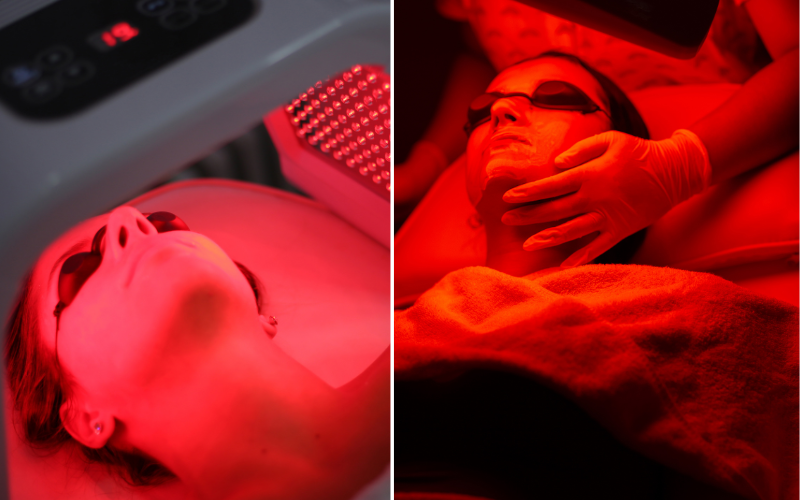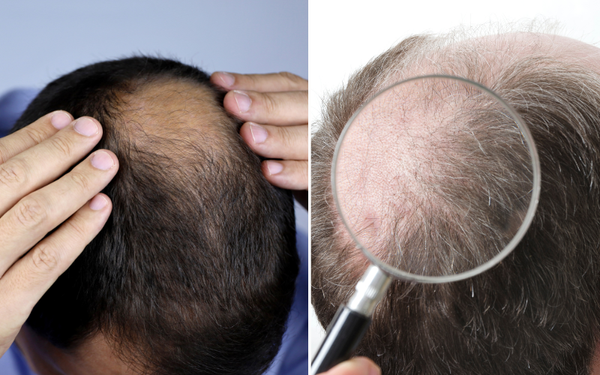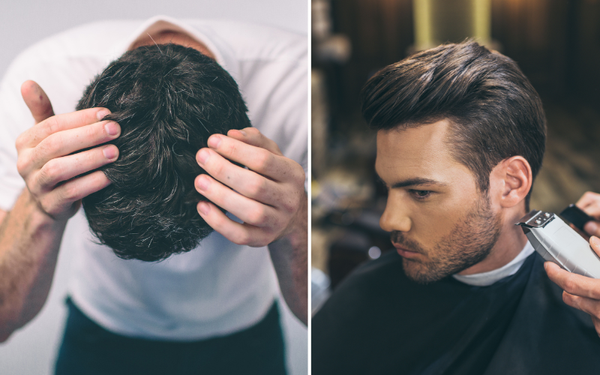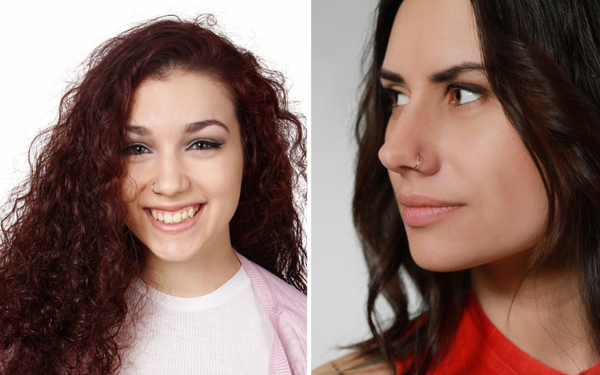Have you ever wondered if the power of light could be harnessed to improve your health and well-being? Discover the world of photobiomodulation and red light therapy, two fascinating therapies that use specific wavelengths of light to target cellular processes and promote healing. But, is photobiomodulation the same as red light therapy? Are they the same thing, or do they have unique applications and mechanisms? Let’s embark on a journey to unveil the truth.
Key Takeaways
- Photobiomodulation and Red Light Therapy are therapeutic techniques that use light energy to stimulate cellular activity.
- Both offer numerous benefits such as enhanced skin health, anti-aging effects, pain management and inflammation reduction.
- Safety precautions should be taken when using photobiomodulation or red light therapy. Professional treatments may be more suitable for those with severe conditions.
Understanding Photobiomodulation and Red Light Therapy

Photobiomodulation and red light therapy, while often confused, possess subtle differences in their applications and mechanisms. While both therapies use light energy to stimulate cellular processes, photobiomodulation is a broader term that encompasses various conditions, whereas red light therapy is mainly employed to enhance physical performance, muscle growth, and recovery time after training.
Both therapies work by penetrating the skin and engaging with billions of cells and trillions of mitochondria within them. The biochemical effect that follows boosts mitochondrial and cellular functionality, aiding in the repair of damaged cells. Commercial red light therapy products typically emit light within the range of 660 to 3000 nanometers, while natural sunlight provides a substantial amount of red and infrared light, which can also be utilized for red light therapy.
Given the multitude of health benefits, the popularity of photobiomodulation and red light therapy has surged in recent years. From skin rejuvenation to pain relief, these therapies offer a non-invasive approach to overall wellness. But what exactly are photobiomodulation and red light therapy, and how do they differ?
What is Photobiomodulation?
Photobiomodulation, a non-invasive therapeutic treatment, uses low wavelength red light from LEDs or lasers to stimulate cellular processes and promote healing. Low level laser therapy operates by interacting with photoacceptors in cells, particularly in mitochondria, to optimize cellular function and facilitate various biological effects within the visible light spectrum.
Photobiomodulation therapy has been proven to have the following benefits:
- Promoting cell proliferation
- Stimulating stem cell differentiation
- Facilitating tissue repair
- Reducing inflammation
- Stimulating growth at the cellular level
These properties make it a flexible treatment option for multiple health conditions, proving its worth in the field of regenerative medicine.
What is Red Light Therapy?
Red Light Therapy specifically refers to the use of red and near-infrared light wavelengths for therapeutic purposes, such as skin rejuvenation and pain relief. It works by targeting specific wavelengths of light within the visible light spectrum to interact with cellular mechanisms, such as increasing ATP production and activating gene transcription factors, to facilitate healing and bolster overall health. If you’re wondering how red light therapy achieves these benefits, it’s through the interaction of these wavelengths with our body’s cells and tissues, including the use of infrared light therapy. By participating in red light therapy sessions, individuals can experience these therapeutic effects firsthand.
The non-invasive aspect of red light therapy is one of its benefits, appealing to those seeking alternative treatments for a variety of health conditions. From enhancing muscle performance and recovery to reducing acute and chronic pain, red light therapy has demonstrated its potential in numerous clinical trials.
The Science Behind Photobiomodulation and Red Light Therapy
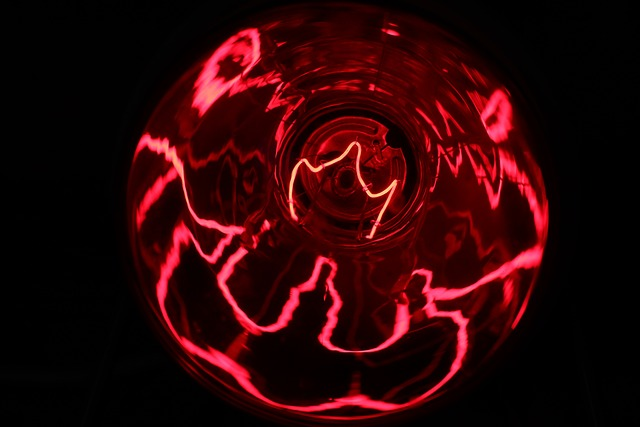
Photobiomodulation and red light therapy primarily work by stimulating cellular processes, thereby increasing energy production and enhancing mitochondrial function. When specific wavelengths of light, such as red and near-infrared, penetrate the skin, they interact with cellular mechanisms like the electron transport chain to:
- Increase ATP production, the primary source of energy for cells
- Enhance cellular metabolism
- Promote collagen production
- Reduce inflammation
- Improve blood circulation
These effects can have various benefits for the body, including accelerated wound healing, reduced pain and inflammation, improved skin health, and enhanced muscle recovery.
This enhanced cellular activity can lead to a cascade of benefits, including increased mitochondrial respiration, cell signaling, and genomic and proteomic responses. This ultimately results in elevated ATP levels, cAMP, and reactive oxygen species (ROS) production, which in turn promote cell growth and proliferation.
The efficacy of these therapies hinges on the specific wavelengths and light spectrums utilized, with red and near-infrared light offering the most advantages. These wavelengths have been found to:
- Advance tissue healing
- Boost angiogenesis
- Improve cellular metabolism
- Reduce inflammation
The specific wavelengths used in photobiomodulation and red light therapy are carefully chosen based on their therapeutic benefits and the outcomes sought.
Cellular Mechanisms
Photobiomodulation and red light therapy alike boost cellular processes by augmenting energy production and enhancing mitochondrial function. For example, photobiomodulation has been shown to:
- Stimulate mitochondrial activity
- Modulate the activity of cytochrome-c oxidase (CCO), a key photoreceptor in the mitochondria
- Lead to improved mitochondrial respiratory complexes and oxidative function
In the case of red light therapy, increased energy production in cells is achieved by activating cytochrome C oxidase, which accelerates electron transport and ATP production. This mechanism promotes cellular rejuvenation and increased mitochondrial energy production, providing a wide range of health benefits.
Wavelengths and Spectrums
The efficacy of photobiomodulation and red light therapy is dependent on the specific wavelengths and light spectrums employed. Research has shown that different wavelengths can have varying effects on biological systems, with red and near-infrared wavelengths being generally utilized in these therapies.
Longer wavelengths tend to penetrate tissue more deeply in photobiomodulation. This allows for deeper penetration and activation of cellular processes, ultimately leading to improved health outcomes. Selecting the appropriate wavelength for the desired therapeutic effect is essential for the success of these therapies.
Comparing the Benefits of Photobiomodulation and Red Light Therapy

Photobiomodulation and red light therapy both offer numerous benefits such as:
- Enhanced skin health
- Anti-aging effects
- Pain management
- Reduction of inflammation
Scientific evidence supports the anti-aging effects of these therapies, as numerous in vitro, in vivo, and clinical studies have demonstrated their anti-inflammatory, repair, skin rejuvenation, and healing effects.
Both therapies have proven effective in managing pain and reducing inflammation by targeting the root cellular processes and fostering healing. This makes them an attractive option for individuals seeking alternative treatments for a wide range of health conditions.
In summation, despite the differences in applications and mechanisms between photobiomodulation and red light therapy, they share numerous common benefits that enhance overall health and well-being.
Skin Health and Anti-Aging
Both photobiomodulation and red light therapy can improve skin health by increasing collagen production, reducing wrinkles, and promoting a youthful appearance. This is achieved through the stimulation of fibroblast production and the decrease of collagen degradation.
Visible enhancements in skin health can be noticed after regular use of photobiomodulation and red light therapy for eight to 12 weeks. The non-invasive nature of these therapies makes them an appealing alternative to more invasive cosmetic procedures.
Pain Management and Inflammation Reduction
Photobiomodulation and red light therapy both aid in pain management and inflammation reduction by addressing the root cellular processes and fostering healing. For example, red light therapy has been shown to enhance joint mobility, alleviate muscle pain, and support arthritis and joint pain relief through increased blood flow to affected tissues.
Moreover, photobiomodulation has been demonstrated to possess the following properties:
- Anti-inflammatory properties in a variety of conditions
- Effective in stimulating healing
- Effective in relieving pain through the application of red and near-infrared light.
Devices and Technologies for Photobiomodulation and Red Light Therapy
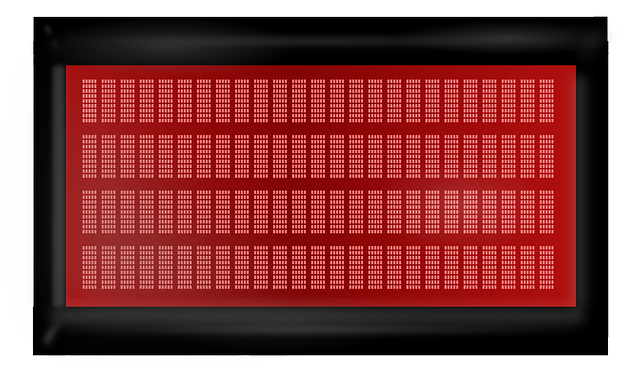
A variety of laser devices and technologies, including laser light and light emitting diode (LED) technology, are available for photobiomodulation and red light therapy. LEDs provide an array of benefits. Firstly, they require no laser safety precautions and their ease of home use is unmatched. Furthermore, LEDs can irradiate a large area of tissue at once, making them desirable for wearable devices. Most importantly, they have a much lower cost per mW than other options. On the other hand, lasers provide increased treatment efficacy, higher power density, and more exact wavelength control.
Selecting a device for photobiomodulation or red light therapy requires considering factors like:
- Wavelength and light intensity
- Treatment area and size
- Portability
- Convenience
- Safety measures
Ultimately, choosing the right device depends on individual needs, preferences, and budget.
Lasers vs. LEDs
Lasers and LEDs both have their advantages and disadvantages in photobiomodulation and red light therapy. Lasers generate a monochromatic and coherent beam of light with low divergence, while LEDs emit a broad spectrum of light.
LEDs tend to be more affordable and accessible for home use, while lasers may offer more targeted and effective treatment. Ultimately, the choice between lasers and LEDs will depend on individual preferences, treatment goals, and budget.
Choosing the Right Device

Selecting the suitable device for photobiomodulation or red light therapy hinges on factors including:
- Wavelength
- Power output
- Treatment area
- Personal preferences
- Budget
It is essential to select the appropriate wavelength for the desired therapeutic effect, as different wavelengths can have varying effects on biological systems.
Additionally, power output significantly influences the effectiveness of these therapies, where higher power density leads to superior therapeutic results and deeper penetration of the light into the body. Taking these factors into account along with the total treatment area can support individuals in making a knowledgeable choice when choosing a device for photobiomodulation or red light therapy.
Practical Tips for Using Photobiomodulation and Red Light Therapy

Both home and professional settings can utilise photobiomodulation and red light therapy, provided safety precautions and guidelines are adhered to. For example, it is essential to commence cautiously and rinse off post-treatment to eliminate any toxins that may have been released.
While considering home devices for low level light therapy, bear in mind that while they may lack the potency of professional treatments, they can still serve for minor ailments and routine maintenance. Contrarily, professional treatments frequently use stronger LED lights, permitting more concentrated and potent therapy.
Home vs. Professional Settings
Home devices for red light therapy, such as a red light therapy device, offer convenience and affordability, although they may not be as effective as professional treatments. However, for individuals seeking a more budget-friendly option or those who prefer the comfort of their own home, these devices can still provide benefits.
Professional treatments in a clinic or dermatologist’s office typically utilize stronger LED lights, allowing for more focused and effective therapy. These treatments may be more suitable for individuals with more severe health conditions or those who seek comprehensive and targeted therapy.
Safety and Precautions
Users of photobiomodulation and red light therapy should adhere to safety guidelines, which include:
- Starting with brief treatment times and gradually increasing
- Maintaining proper hydration
- Seeking advice from a healthcare professional before initiating treatment
Also, potential interactions with medications should be considered, as specific medications, such as antihistamines and antibiotics, may interfere with red light therapy. Always consult with a healthcare professional prior to undergoing these therapies if you are taking any medications or have a medical history.
Summary
In conclusion, photobiomodulation and red light therapy offer numerous benefits for overall health and well-being, including improved skin health, anti-aging effects, pain management, and inflammation reduction. While they share similarities, these therapies have subtle differences in their applications and mechanisms. With various devices and technologies available, individuals can choose the therapy that best suits their needs and preferences. By following safety precautions and guidelines, users can harness the power of light to enhance their health and quality of life.
Frequently Asked Questions
Is photobiomodulation the same as red light?
Yes, red light is a type of photobiomodulation (PBM) therapy. PBM is a therapeutic treatment that uses low wavelength red light and near-infrared light to help the body heal. Infrared light is a type of energy that can't be seen by the human eye, but red light is visible and similar to infrared.
What is another name for photobiomodulation?
Photobiomodulation (PBM) therapy is the commonly used term in place of low level laser therapy (LLLT), cold laser, or laser therapy.
What is the main difference between photobiomodulation and red light therapy?
Photobiomodulation is a more encompassing term than red light therapy, which primarily aids physical performance, muscle growth, and post-exercise recovery.
Can I use photobiomodulation or red light therapy at home?
Yes, you can use photobiomodulation and red light therapy at home with devices specially designed for that purpose. However, they may not provide the same level of potency as professional treatments.
How long should I use red light therapy for the best results?
For the best results, start with 10-20 minute red light therapy sessions, three to five times per week. Adjust your duration and frequency as needed.
You Might Also Like...
